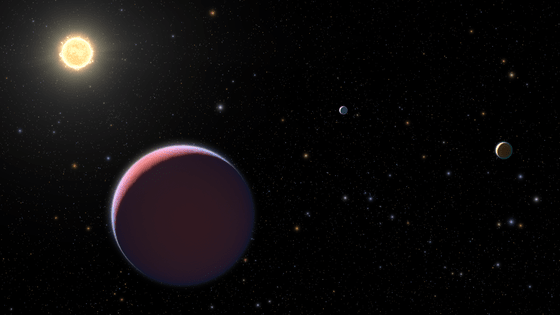NASA announces the identity of 'a planet like cotton candy floating in space'

by
NASA has released details of a very low density planet observed by the Hubble Space Telescope. The planet of the Kepler 51 system located about 2600 light years away from the earth is the lowest density among known planets, and it is called a `` super puff planet '' because it is like a fluffy cotton candy .
[1910.12988] The Featureless Transmission Spectra of Two Super-Puff Planets
https://arxiv.org/abs/1910.12988
'Cotton Candy' Planet Mysteries Unravel in New Hubble Observations | NASA
https://www.nasa.gov/feature/goddard/2019/cotton-candy-planet-mysteries-unravel-in-new-hubble-observations
New class of 'cotton candy' exoplanets are the lightest ever found :: WRAL.com
https://www.wral.com/new-class-of-cotton-candy-exoplanets-are-the-lightest-ever-found/18843837/
'Super-puffy' planets add cotton candy flavor to search for alien worlds? GeekWire
https://www.geekwire.com/2019/super-puffy-planets-add-cotton-candy-flavor-search-alien-worlds/
The three planets Kepler 51b, Kepler 51c, and Kepler 51d in the Kepler 51 system were discovered by the Kepler Space Telescope, which ended operation on November 15, 2018 . Although it was known that the density was quite low since the discovery in 2012, details such as what kind of material it was made have not been clarified. Therefore, a research team such as Jessica Libby Roberts, who is studying planetary science at the University of Colorado, conducted detailed observations of three planets using the Hubble Space Telescope.
The following three planets are 'Kepler 51b', 'Kepler 51c' and 'Kepler 51d'. The lower row is Earth, Neptune, Uranus, Saturn, Jupiter from the left.

As a result of observation by the
The research team then tried to investigate the materials that make up Kepler 51b and Kepler 51d by analyzing the transmission spectrum , but it was not possible to obtain data on the chemical composition by being blocked by thick clouds. I couldn't. However, since we know that there is no water in the planet's atmosphere, we have determined from these observations and simulations that most of the masses of the two planets are hydrogen and helium. According to Libby Roberts, the reason why he couldn't examine the planet's atmosphere was “the same as Saturn ’s moon, Titan , because it ’s covered by a thick layer of methane gas. When methane gas is decomposed by ultraviolet rays, it produces a dense gas rich in carbonaceous matter. ”
The Kepler 51b, Kepler 51c, and Kepler 51d are so low in density that the three planets are outside of the snow line , which is a sufficient distance for hydrogen compounds such as methane to agglomerate and become solid. It is speculated that it was born and then moved near the stars. Of the three planets, Kepler 51b, which is the closest to a star, was blown out of the atmosphere at a speed of tens of billions of tons per second, so it was as small as Neptune about 1 billion years later. It will be a planet.

Claire Andreoli, who works for NASA's Goddard Space Flight Center, said, “With the state-of-the-art James Webb space telescope that NASA will begin operating in the near future, we can learn more about how cotton candy was made in space. It ’s possible, but until then, it ’s still a sweet secret. ”
Related Posts:
in Note, Posted by log1l_ks







